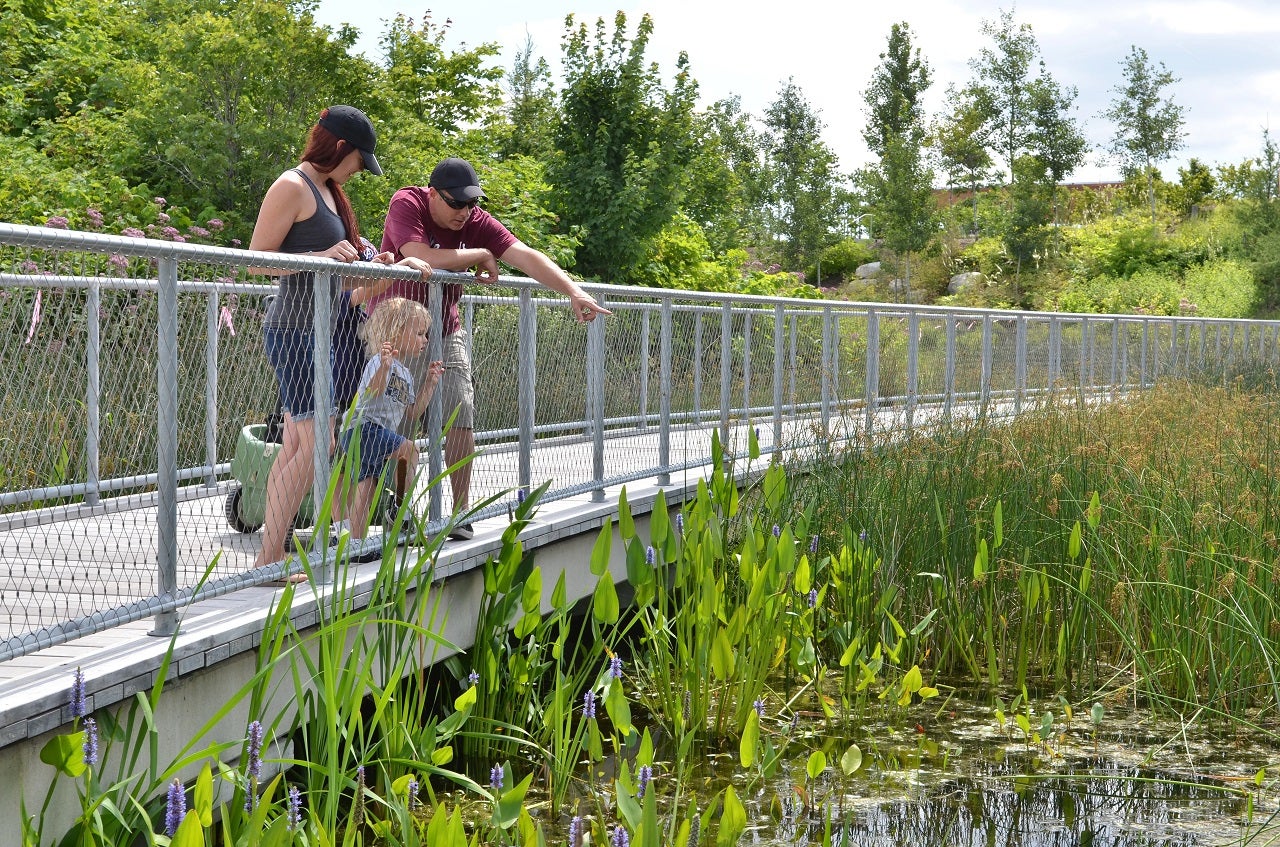Embracing biodiverse landscapes for a better planet
PUBLISHED: APRIL 30, 2024
In This Blog:
- We are building biodiverse ecosystems that are helping combat climate change while also creating more enjoyable spaces for residents and visitors alike.
- Corktown Common, Port Lands Flood Protection, and Quayside’s public spaces are examples of this approach.
- Biodiverse landscapes offer a myriad of benefits for people and the planet.
- This nature first approach can also support Indigenous ways of knowing and being.
- By greening the urban environment, we can also enhance community well-being.
Spring has sprung and all across the waterfront there are signs of new life – buds appearing on the maples that line the Water’s Edge Promenade, aquatic birds visiting to the new wetlands created as part of the Port Lands Flood Protection project, and frogs croaking in the marsh at Corktown Common.
Being the season of renewal and Earth month, this is an opportune time to think about our impact on the environment and what we are doing to support a more sustainable and resilient city.
Moving from “manicured” to “wild”
Creating beautiful and inviting parks and public spaces that attract people to the waterfront is central to our mandate. When you look closely at these spaces, you’ll also see that we are building biodiverse ecosystems that are helping combat climate change while also creating more enjoyable spaces for residents and visitors alike.

Corktown Common marsh acts as both a natural habitat and a stormwater management system.
Corktown Common is a great example of this approach. This beloved park comprises a series of ecologically diverse native habitats, it captures, treats and reuses stormwater onsite and sits on top of a complex landform that is protecting a vast swath of land from the risk of flooding. At the Port Lands, we are taking the concept of rewilding to a new level by creating a naturalized mouth for the Don River, new wetland habitats and a host of other earth friendly approaches in our efforts to flood protect the area.
Building on this work and informed by learnings from planting pilots along Queens Quay West and Lake Shore Boulevard, the approach we are taking with the Water’s Edge Promenade in Quayside will see a transition to open tree planters with native plants that will provide habitat for pollinators and animals.

Artist’s rendering of the Water’s Edge Promenade at Quayside with open planters and understory.
Although this type of landscape can sometimes look more untamed than a manicured lawn or an allée of perfectly spaced trees contained within a narrow hardscape opening, they aim to recreate natural ecosystems and offer a myriad of benefits.
- Planting trees in open soil areas improves tree resilience and enhances conditions for growth and longevity.
- Open planters with an understory of diverse plants add more greenery to our public spaces, boost carbon sequestration, enhance air quality, reduce the heat island effect, and promote stormwater absorption.
- Using native species that are better suited to local climate and soil conditions means less maintenance is needed and provides crucial support to local biodiversity by offering food and habitat to native wildlife.
- Longer stretches of natural plantings provide corridors for wildlife.
In addition, a growing body of research [PDF] shows that living close to nature offers many benefits to people. By greening the urban environment, we provide areas for recreation, relaxation, shade, and social interaction, ultimately improving mental health and quality of life.
Highlighting Indigenous Ways of Knowing and Being
This nature first approach can also support connections with Indigenous communities. We’ve been working closely with Indigenous partners at MinoKamik Collective, a group of Indigenous Elders and plant and species subject matter experts, on both our Quayside and the Port Lands Flood Protection projects. With their advice and guidance, we’re using these approaches to honour traditional knowledge, promote environmental stewardship, empower Indigenous voices, foster healing, and raise awareness of Indigenous presence and contributions to the land. Together we are acknowledging the ongoing relationship between Indigenous peoples and the land and promoting understanding and respect among all residents.

Indigenous partners at MinoKamik Collective have been integral to the selection of plants and species for the Port Lands Flood Protection project.
So, when you see the tangled colourful lush new urban wetlands and trails at the Port Lands and the open planters along the Water’s Edge Promenade with an understory of native shrubs and flowers, remember they are doing a really important job: They are helping us create greener, healthier, and more vibrant spaces that benefit residents, wildlife, and the planet as a whole.
Stay up to date on the exciting work that is happening along Toronto’s waterfront by subscribing to our newsletter [LINK].




